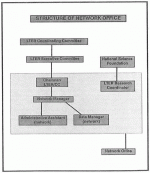While the concept of LTER sites operating as a network has been around since the inception of the program, it has been slow to develop. The individual LTER sites have been extremely busy getting their programs into place-- establishing experiments, implementing data management procedures, developing functional teams, etc. There is the scientists’ inherent suspicion of standardization in most forms and distaste for formalized administrative structures, including coordinating committees, in any form.
The LTER program is maturing, however. LTER has a very high profile and, consequently, expectations of our peers and the National Science Foundation are also high. We are beginning to appreciate that our ability to function and produce as a network is as critical to the long-term success and survival of the LTER program as success of individual site programs. More important, we are recognizing huge potential of the LTER network in advancing ecological science.
Last November at the LTER Coordinating Committee meeting held at the Kellogg Biological Station the Committee moved aggressively in assuming more of the responsibilities of a scientific network. Significant steps were taken which will help develop the network as an entity. These steps included:
- A decision to develop a five-year strategic plan for the LTER network which will also require us to identify our collective objectives
- Adoption of some common standards for the hardware and software necessary for communication among the LTER sites, including the exchange and collaborative analysis of data--the Minimum Standard Installation (MSI)
- Establishment of an enlarged and centralized network office on the University of Washington campus in Seattle
Development of a strategic plan is the most challenging project that the LTER Coordinating Committee has undertaken. It is increasingly clear that we need a collective vision of how we want the LTER network to evolve. We have adopted a 5-year planning horizon. A central element of this plan will be long-term goals. Work on identification and definition of these goals began last spring and will accelerate at an April meeting in Albuquerque, New Mexico. Other elements in the plan include identification of the organizational elements (such as intersite modeling or data management groups, for example) and essential common measurement programs (observational and experimental) necessary to achieve the goals. The strategic plan will also need to identify critical resource needs--such as technologies, scientific personnel, and funds.
Substantial work has already begun on the issue of technologies. A committee chaired by Dr. H.H. Shugart began the work on technology assessments in 1988 and primarily addressed computer and geographic information systems (GIS) needs. The MSI concept is an outgrowth of that work. A special committee chaired by Dr. James Gosz met in January to further expand our considerations of technological needs in the LTER network and draft the segment of the strategic plan that deals with that issue. The technologies under discussion range from the molecular to remote sensing of landscapes by satellite. We will also attempt to identify critical needs in technological development.
The MSI is based on the concept that there needs to be a minimum and standardized technological capability common to all sites if the network is to communicate and be able to carry out intersite (network) scientific goals. It is important to recognize that the MSI is an evolving concept, rather than a set of standards that is set in concrete; additions and modifications (including greater specificity) are going to occur. Nonetheless, the MSI provides a starting point for commonality.
Currently, the MSI includes acquisition of a GIS system, including computer, high-resolution color screen, digitizer, plotter, software, and essential staff; development of a local area network (LAN) and linkage with a wide-area network (WAN); and acquisition of a high-capacity archival mass- storage system consisting of an optical disk drive (such as a WORM--”write once read many times). More detailed specifications have been developed to guide equipment acquisition by the LTER sites during 1989. Work by an ad-hoc GIS committee chaired by Dr. David Foster is further exploring issues of standardization and software development in this complicated area; this group began its work at a meeting at Harvard Forest in December 1988.
Expansion of the network office and its concentration in one locality is long since overdue. The office has now moved from Corvallis, Oregon to Seattle, Washington. We plan to have three full-time employees at Seattle in addition to Research Coordinator Dr. Caroline Bledsoe (who is currently employed by the National Science Foundation and will be spending half of her time in Seattle) and myself. The full-time staff will include an Administrative Assistant (Stephanie Martin, who will handle a variety of tasks, including publications), a Data Manager, and a Network Manger. The Data Manager will be devoted to facilitating data exchange between sites and development of large problem-oriented data bases. The Network Manager is visualized as a trained scientist that will function as an executive officer for the LTER Coordinating Committee, representing the network and developing details on network research, training, and planning.
These steps represent significant forward progress in development of a truly functional LTER network. I look forward to greatly expanded participation in planning and conducting the network activities by scientists interested in long-term ecological research, both Inside and outside of the formal LTER network.

 Enlarge this image
Enlarge this image